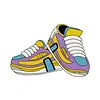Why Sonic is a Cultural Icon
Sonic the Hedgehog is more than just a video game character; he has evolved into a global icon. With his characteristic blue fur, lightning-fast speed, and unmistakable attitude, Sonic has captured the hearts of millions. Sonic symbolizes a sense of adventure, rebelliousness, and the power of innovation in the gaming world.
A Brief Look at Sonic's Influence on Gaming and Pop Culture
Since his debut in 1991, Sonic has not only spawned countless games but also ventured into animations, comics, and even a successful movie. His influence extends beyond gaming; he has shaped pop culture in various ways and remains a recognizable name, even among new generations.
The Early Days of SEGA
SEGA's Position in the 1980s
In the 1980s, SEGA was a significant player in the arcade industry, but their home consoles struggled to gain a substantial market share. Nintendo dominated with the NES and had a large lead thanks to iconic franchises like Super Mario Bros. SEGA knew they needed something spectacular to stand out.
The Challenge of Nintendo's Dominance
Nintendo's hold on the market was formidable. They not only had the most popular games but also maintained strict control over third-party developers. SEGA needed to find a way to position themselves as an attractive, innovative option for gamers looking for something different.
The Need for a Mascot
Why SEGA Needed a Recognizable Mascot
Nintendo had Mario, a lovable character that was the symbol of their brand. SEGA realized they needed a similar mascot to strengthen their brand identity. A recognizable character could not only sell games but also position SEGA as a modern and youthful alternative.
The Concept of a 'Console Seller'
The idea of a 'console seller' was crucial at the time. A mascot needed to not only make a game popular but also make an entire console appealing. This became the core of SEGA’s strategy: create a character that appealed to both children and teenagers.
The Creation of Sonic
The Team Behind Sonic: Yuji Naka, Naoto Ohshima, and Hirokazu Yasuhara
The development of Sonic was the result of a creative team within SEGA. Programmer Yuji Naka brought technical expertise, while Naoto Ohshima created Sonic’s iconic design. Hirokazu Yasuhara provided the smart level design that combined speed and gameplay.
The Brainstorming Sessions: From Ideas to Design
During brainstorming sessions, a range of ideas emerged, from a rabbit to a platypus. Ultimately, the choice fell on a blue hedgehog, a striking and unique choice that perfectly matched SEGA’s image of innovation and daring.
The Design of Sonic
The Inspiration Behind Sonic's Appearance
Sonic’s design was inspired by various elements, including Mickey Mouse and Felix the Cat. His large eyes and simple shapes made him easily recognizable and easy to animate.
Why Blue Was the Perfect Color
Blue was chosen because it matched SEGA’s logo and visually stood out. It also reinforced Sonic's calm yet confident character.
The Use of Sneakers as a Fashion Statement
The red sneakers were inspired by Michael Jackson’s Bad album and symbolized speed and style. They gave Sonic a modern, contemporary feel that set him apart from other mascots.
Naming the Character
Why 'Sonic' Was the Final Choice
The name "Sonic" was chosen to emphasize the character's speed. It was short, powerful, and easy to remember.
Other Names Considered
Before the name Sonic was chosen, options like "Mr. Needlemouse" were considered. While these names were original, they lacked the universal appeal that Sonic had.
The Emergence of the Game Concept
Focusing on Speed as Core Mechanic
The idea behind Sonic was speed. This set the game apart from other platformers and maximized the technical capabilities of the SEGA Genesis.
How Level Design Emphasized Sonic's Speed
The levels were designed to maintain momentum. Players were encouraged to take risks, which created a dynamic and challenging gameplay experience.
The Development of the First Game
Technical Challenges and Innovations
Developing Sonic the Hedgehog presented challenges. Yuji Naka worked on techniques to allow Sonic to move smoothly through levels, something that was revolutionary at the time.
Utilizing SEGA Genesis Hardware
The SEGA Genesis offered more powerful hardware than the NES, allowing for fast gameplay and colorful graphics. This gave Sonic a clear technical advantage.
The Release of Sonic the Hedgehog
SEGA's Marketing Strategy
SEGA went all-in on marketing Sonic. They positioned him as the ‘cool’ counterpart to Mario, targeting a younger, hipper audience.
Positioning Sonic as Mario's Rival
With slogans like "Genesis Does What Nintendon’t," Sonic was positioned as the modern alternative. This created enormous appeal among gamers looking for something new.
Conclusion
Sonic's journey from a brainstorming idea to a global phenomenon showcases the power of innovation, persistence, and creativity. His impact on gaming and pop culture is undeniable, and he remains a symbol of speed, style, and adventure. Sonic is more than a mascot; he is a legend.




 Themes
Themes
 Clothing
Clothing
 Shoes
Shoes
 Bags
Bags
 Children's room
Children's room
 Travel
Travel
 Gifts
Gifts
 School
School
 Other
Other
 Sale
Sale
 Blogs
Blogs










